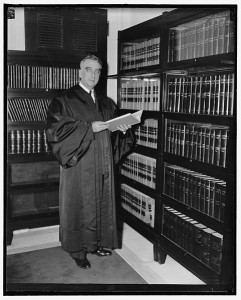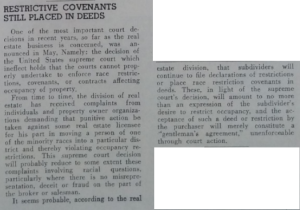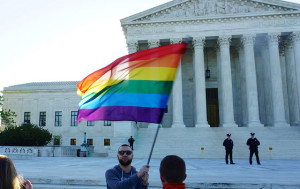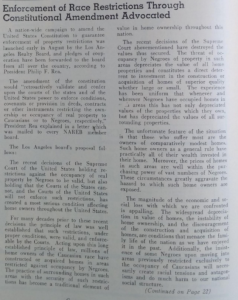



We hold that in granting judicial enforcement of the restrictive agreements in these cases, the States have denied petitioners the equal protection of the laws and that, therefore, the action of the state courts cannot stand. We have noted that freedom from discrimination by the States in the enjoyment of property rights was among the basic objectives sought to be effectuated by the framers of the Fourteenth Amendment. That such discrimination has occurred in these cases is clear. Because of the race or color of these petitioners they have been denied rights of ownership or occupancy enjoyed as a matter of course by other citizens of different race or color. The Fourteenth Amendment declares ‘that all persons, whether colored or white, shall stand equal before the laws of the States, and, in regard to the colored race, for whose protection the amendment was primarily designed, that no discrimination shall be made against them by law because of their color.’

Of course, at this late date, we have no way to know what the members of the CREA were thinking other than through the written record. Fortunately a significant part of the discussion was preserved in California Real Estate Magazine, house organ of CREA and, later, CAR. Worldcat indicates that the LAPL owns this journal, but, after some checking, it turned out that their holdings were destroyed in the fire. However, UCLA has copies going back to 1923, so we sent Mike out there on the number 2 bus to get us the goods. Here is what he found!



The recent race restrictions decisions of the United States Supreme Court of May 3, 1948 established an important change in what courts and lawyers generally considered was well established law.
The Principle
It has long been an established principal of constitutional law that no state could discriminate on the basis of race or color insofar as state action was concerned. This rule covered legislative action, such as laws and ordinances requiring negroes to live on one side of a line and whites on another.
This principle also covered administrative action, such as the granting of laundry permits to whites only and uniformly denying them to Chinese. It also covered judicial action such as the requirement for a white jury. It however had been generally understood by both the courts and the lawyers that this rule did not affect the judicial enforcement of rights based on lawful contracts.
The recent decisions of the United States Supreme Court have, however, held that no contract which discriminates on the basis of race or color will be given any enforcement whatsoever by either the state or federal courts.
The decision was based upon the court’s new interpretation of that portion of the Fourteenth Amendment of the United States Constitution reading as follows:
“No state shall…deny to any person within its jurisdiction the equal protection of the laws.”

Breed next moves on to ways to get around the decision. He lists whole bunches of them, and all of them were tried, with varying degrees of success, in the real world before, theoretically, the Fair Housing Act of 1968 put an end to them.6 The most interesting of these has to do with homeowner associations. This kind of thing probably would have been quite effective, and see what Breed identifies as a major advantage!
The issuance of the permit [to purchase a home] is discretionary and without reference to race or color, but based entirely upon personal qualifications as a good neighbor, or in other words, cultural status. This is an extension of the idea that any club may regulate admission to its membership. Many a country club restricts occupancy of home sites on its grounds to its members. Religious colonies have long been established on the same basis.
The advantage…is that it will permit exclusion of undesirable whites. If fairly administered so as to exclude undesirable persons irrespective of race or color, no difficulty should be encountered in its enforcement.
We mean, OK, right? The end of racially restrictive covenants opens the door to keeping white trash as well as n******s out of the neighborhood? Craziness. But very interesting craziness nevertheless. We can see Lee Atwater’s famous description of the Southern Strategy developing here in real time. The Supreme Court says that the government will no longer enforce racist contracts? No problemo! Just make the contracts race-neutral in a way that not only keeps out minorities but “undesirable whites” as well. As Lee Atwater said, “…all these things you’re talking about are totally economic things and a byproduct of them is [that] blacks get hurt worse than whites.”
But in the end, Breed realizes that all that’s really left to white supremacy is a reliance on the (plausibly still-extant-under-Shelley) right of private property owners to sell to whomever they please:
As all know, a licensed real estate broker is an agent and bound by the laws of agency. As such he must use ordinary diligence to keep his principal informed of his acts in the course of his agency. This is elementary and statutory. Therefore, if a broker holding a listing receives a bona fide offer from any prospective purchaser [in other words, a negro], offering to buy at the price and upon the terms of his listing, it is the duty of the broker to notify his principal, the owner.
…
With information at hand [the broker tells the owner that the prospective purchaser is a negro], the owner may reject the offer. Neither the Fourteenth Amendment nor the Shelley decision requires the owner to sell. Furthermore, most deposit receipts, certainly the standard form of the state association, provides that the property is sold subject to the approval of the seller. That is as it should be.
The usual form of listing does not have a saving clause for the benefit of the owner. In those cases where the property is restricted [he means WAS restricted—old habits die hard], I recommend that the listing have some such saving clause as “No sale shall be made contrary to restrictions.” Even where there be no restrictions, but the neighborhood is in fact a Caucasian neighborhood, the owner might prefer to have some saving clause, as “Sale must be only to persons of Caucasian race.”
Whatever the flaws of his approach, Breed has the sense to see that, with Shelley, everything has “changed, changed utterly.” He says:
It should be noted that the effects of this argument and this ruling go far beyond the limited subject of restrictive racial covenants…It is an extraordinarily far-reaching rule.


The recent decisions of the Supreme Court of the United States holding restrictions against the occupancy of real property by Negroes to be valid, but also holding that the Courts of the States, and the Courts of the United States will not enforce such restrictions, has created a most serious condition affecting home owners throughout the United States.
Note the refusal to state exactly what the problem is. It’s not “a bunch of n******s are moving on to my block,” it’s “a most serious condition.” This kind of vague wink-wink-nudge-nudge is characteristic of 20th Century white supremacism. We see it in the founding documents of segregation academies. We see it in the Southern Manifesto, infamously presented to the United States Senate in response to another earth-shattering civil rights case, Brown v. Board of Education. For instance, when presenting the Southern Manifesto to the Senate, Senator Walter F. George in reference to Brown v. Board discussed “…sections of the country where this decision has created many difficulties, unknown and unappreciated, perhaps, by many people residing in other parts of the country…” This kind of weird mealy-mouthed euphemism is an infallible signifier of white supremacy. It’s in Klan documents, in Citizens’ Council documents, it’s everywhere. They all write like that for some reason.
For many decades prior to these recent decisions the principle of law was well established that such restrictions, under proper conditions, were valid, and enforceable by the Courts. Acting upon this long established principle of law, millions of home owners of the Caucasian race have constructed or acquired homes in areas restricted against occupancy by Negroes. the practice of surrounding homes in such areas with the security of such restrictions has become a traditional element of value in home ownership throughout this nation.
See, again, it’s “well established law.” White people all over the country have been relying on it, so, just as H.C. Breed said in his column, discussed above, the Court shouldn’t change it. This is an argument well-favored by white supremacists. “We’ve always done it that way.” “This is our tradition.” “Heritage, not hate.” Interestingly albeit unsurprisingly given its status as one of the founding documents of late 20th Century white supremacism we see this in the Southern Manifesto as well: “The unwarranted decision of the Supreme Court in the public school cases is now bearing the fruit always produced when men substitute naked power for established law.” Or again: “Though there has been no constitutional amendment or act of Congress changing this established legal principle almost a century old, the Supreme Court of the United States, with no legal basis for such action, undertook to exercise their naked judicial power and substituted their personal political and social ideas for the established law of the land.” It’d be kind of a laugh, seeing these Southern heirs of the grand Southern traditions of slavery, lynching, and rape complaining about “naked power” being substituted for “established law” after their having held off enforcement of the Fourteenth Amendment and all the other Reconstruction legislation for some 90 years by that point using sheer, bloodthirsty violence. The irony is thick, but the blood poured out on the rich cotton fields of the South is thick too. There’s nothing here to laugh about.
The recent decisions of the Supreme Court abovementioned have destroyed the values thus secured. The threat of occupancy by Negroes of property in such areas depreciates the value of all home properties and constitutes a direct deterrent to investment in the construction or acquisition of homes of superior quality whether large or small. The experience has been uniform that whenever and wherever Negroes have occupied homes in such areas this has not only depreciated values of the properties which they own, but has depreciated the values of all surrounding properties.
As offensive as this is, and as unbelievable as it may be to we denizens of the 21st Century that people would actually write stuff like this and distribute it publicly with their names on it, it’s probably the only actually true part of the whole screed. Here’s how it works. White people, and especially real-estate agents, distorted the actual market via racial segregation. This had the effect of keeping prices artificially high in white areas and artificially low in black areas. The real-estaties made tons of money by controlling the boundaries, just as they continue to do today, albeit to a slightly more limited extent. Thus, when areas become integrated, local value is lost if blacks move into a white neighborhood and local value is gained if it’s the other way round. All-white areas become even more valuable because the shrinking supply drives up the price. However, and this is what these whining racists are ignoring, the aggregate value of property in the market has got to stay the same or go up, since it’s ultimately determined by the capital available for home-buying and the efficiency of the market. So, in the end, what they’re complaining of is not really that property values go down, but that they lose control over the market-distortion process and, therefore, the ability to exploit it for their own benefits. Somehow the potential redemption of lives that are bent, broken, destroyed by segregation doesn’t appear in their calculations. They’re essentially arguing in favor of slavery because THINK OF THE ECONOMIC VALUE THAT WOULD BE DESTROYED BY EMANCIPATION!!1! This is an argument that was actually made against abolition in this country before 1861, and it’s as wrong now as it was in 1948 or 1848.
The unfortunate feature of the situation is that those who suffer most are the owners of comparatively modest homes. Such home owners as a general rule have practically all their wealth invested in their home. Moreover, the prices of homes in such areas are well within the purchasing power of vast numbers of Negroes. These circumstances greatly aggravate the hazard to which such home owners are exposed.
And here’s our old friend the “We’re primarily thinking of struggling middle-class white people” argument. They mostly care about white owners of modest homes, sez they. We’ve seen our BIDs turn to this kind of argument against street vending, where, e.g., Kerry Morrison falsely claims that her BID represents small business and she falsely claims that opponents of street vending represent small business. Everybody hates zillionaires, so evil-doers of every stripe must universally claim to represent middle-class people. In this particular case it’s middle-class white people, because the economic gains (to say nothing of the human, live-giving, spiritual gains) to be realized by middle-class black people because of Shelley go unmentioned entirely.

Anyway, that’s the story of the California Real Estate Association in 1948. Now back to Kerry Morrison (remember Kerry? This post’s about Kerry). According to her biosnip from the HPOA website, she worked for the successor organization to the CREA for 14 years prior to coming to work for the BID in 1996. Now, we’ve demonstrated conclusively that the CREA was a white supremacist organization in 1948. We’ll be seeing evidence later that it continued to be a white supremacist organization well into the 1960s and probably beyond. We’ve noted in extensive detail most everywhere on this blog that the HPOA and the two BIDs it runs are also white supremacist organizations. They’re all racists, and Kerry Morrison is the living link between the two nexuses of racism. This is not a coincidence.
Now, maybe you’re thinking that 1948 was a long, long time ago and what connection could there possibly be between then and circa 1983, when Kerry went to work for the REALTORS®? But really, it’s only 35 years between the two. If white supremacists didn’t hire Kerry at the CAR, then people who were hired by white supremacists hired her. The fact is, as anyone who’s lived in the South can attest, that cultures of white supremacy are quite persistent. The environment in which Kerry worked was formed, was shaped by white supremacy. The air she breathed was white supremacist air. Most importantly, the culture in which she thrived and was comfortable in at CAR was white supremacist culture. That’s the sensibility she necessarily brought to the BID upon its foundation in 1996. It was born in white supremacy and continues in white supremacy. It’s not just random that the BID’s founders hired a white-supremacist-nurtured executive directrix, and it’s not just random that, under her foundational guidance, the HPOA has continued to spread white supremacy in Hollywood at the point of a gun. They’re all so freaking COMFY with one another. They have a unity of purpose. It’s disheartening, dismaying, demoralizing, daunting, and dastardly.
If you still believe this is all a coincidence, do a little thought experiment. Remember Loren Miller and Thurgood Marshall from the NAACP Legal Defense Fund? Read up on them on Wikipedia if you’re not conversant with the organization. Then ask yourself whether it’s remotely plausible that someone could conceivably become the executive director of the HPOA and turn it into what it is today if they’d worked 14 years at LDF. It’s just not plausible. The HPOA is not the kind of organization that Thurgood Marshall could have run, and that essentially proves that it’s no coincidence that Kerry Morrison worked for the CAR before conjuring up the HPOA out of nothing but the sick, twisted dreams of a bunch of white Hollywood zillionaires.

As a reward for making it all the way to the end here, take a look at this classified ad from the March 1948 issue of California Real Estate. Can you imagine what that house is worth today??! It’s interesting to note that $27,500 in 1948 money is only $272,300 in 2015 money. Unbelievable, isn’t it?
- Interestingly, it turns out that there is a fascinating story behind this typographical oddity. We don’t have space for it in today’s post, but we hope to cover it in detail later.
- See The Promise and Principles of Real Estate Development in an American Metropolis: Los Angeles 1903-1923, Laura Redford, Ph.D. Dissertation, UCLA 2014, p.42n: “The present-day name of this organization is the California Association of Realtors (CAR). The group formed under the name the California State Real Estate Federation and used it until 1917, when it became the California Real Estate Association. For clarity, I have chosen to refer to the organization as CREA.” Ordinarily dissertations make dismal reading, but Redford’s prose is quite sprightly and her subject matter fascinating. It’s also quite important for understanding the metropolitan development of Los Angeles. We wish we had the time to go into it in more detail, but we don’t. However, we heartily recommend it!
- As always we have to omit some details here. Shelley v. Kraemer left open one little loophole, which white supremacists set out immediately to exploit. It was closed up later, but, again, we have neither the time nor the space to go into it.
- From January 1948 issue of California Real Estate, p.12.
- Restrictive Covenants Still Placed in Deeds. California Real Estate. June 1948, p.33.
- It didn’t. In fact, there’s an awful lot of racial segregation in housing even right here in sunny Los Angeles, even right down to the present day. It’s mostly that, as Lee Atwater so memorably explained, everything’s had to get so much more covert.
- Enforcement of Race Restrictions Through Constitutional Amendment Advocated. CRE Magazine. September 1948, p.4.
Image of Morrison and Garcetti is public domain because it’s a freaking public record, got it? Beautifully faked-up postcard is released by its creator, Vicci, under the CC BY 2.5, and is available from her blog here. We found the image of Loren Miller here, and they say it’s in the public domain. We have no reason to doubt their word. Image of Thurgood Marshall is in the public domain because of some complex copyright voodoo that we aren’t going to bother understanding since the copyright houngans over at Wikimedia, where we done got the picture from, has done the heavy lifting for us. Images from California Real Estate Magazine appear here under a claim of fair use. Image of rainbow flag in front of Supreme Court has been released by its creator, Ted Eytan, under the CC BY-SA 2.0 and you can, as did we, get it from Flickr. Arthur Rackham’s lovely drawing of Pandora is in the public domain due to its age and we got it from the usual suspects. Image of constitution toilet paper is by jonolan, who has released it under a CC BY 3.0 US.
